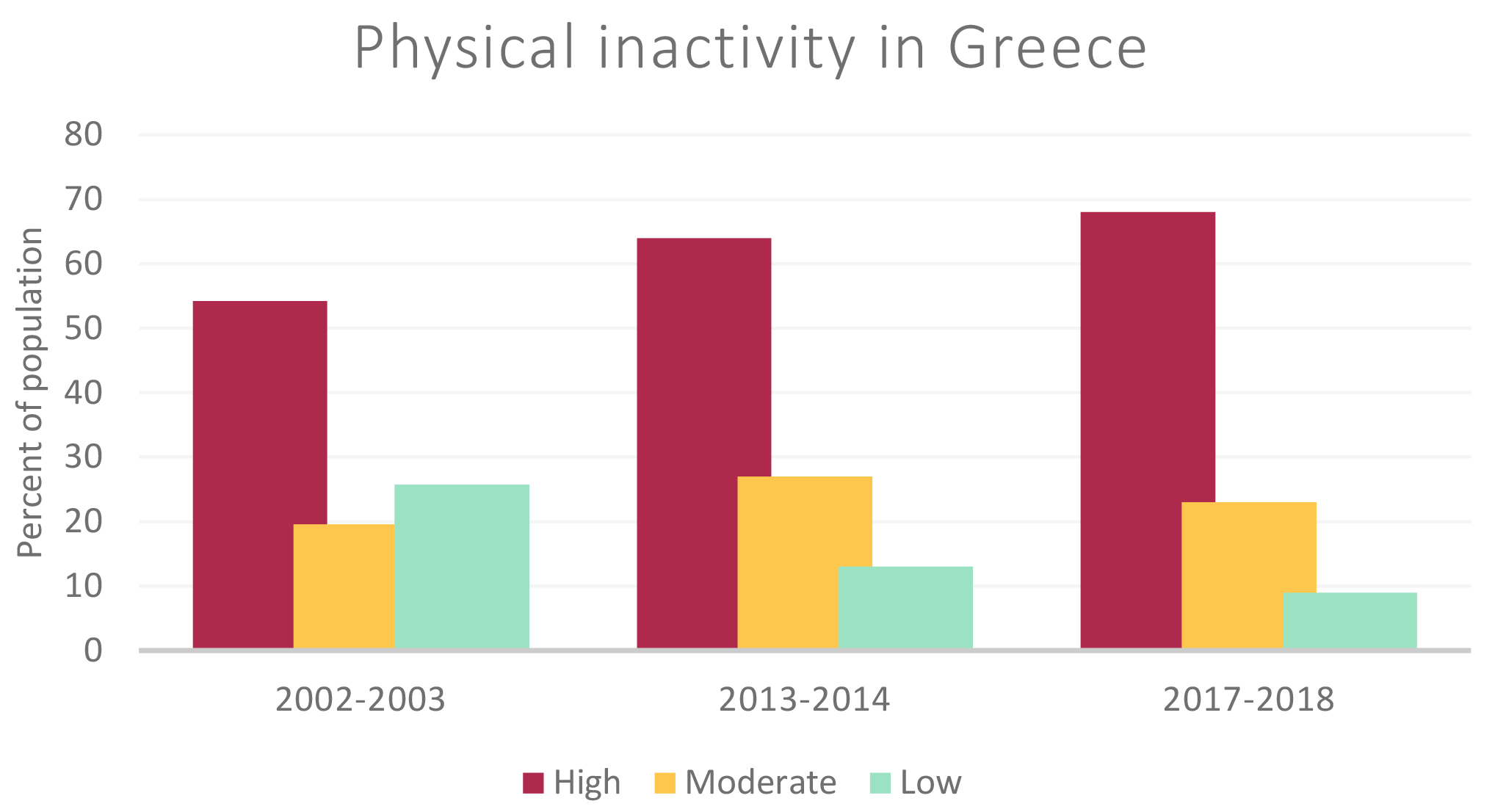Physical inactivity: a global public health problem
Physical inactivity refers to sedentary lifestyle behaviors, such as sitting or lying down for several hours daily (World Health Organization, 2018). Sedentary lifestyle is a risk factor for the leading non-communicable diseases, namely heart disease, stroke, diabetes, as well as breast and colon cancer.
Physical inactivity in Greece
In most economically developed countries, the levels of physical inactivity are high due to the availability of transportation means, the use of technology, as well as urbanization. In Greece, the percentage of the population that demonstrates high physical inactivity has increased from 54% in 2002 to 68% in 2018 (chart to the left) (European Commission 2003, 2014, 2018). Besides health, do these high levels of physical inactivity translate to economic consequences?
Economic effects of physical inactivity in Greece
Using internationally established methodology (Ding et al., 2016) designed to assess the impacts of inactivity on the five leading non-communicable diseases – namely heart disease, stroke, diabetes, as well as breast and colon cancer – we assessed the economic impacts of physical inactivity in Greece during the period 2000-2019. Our estimates include only the five leading non-communicable diseases given the extensive available knowledge about how they are linked with physical inactivity. We found that the total economic cost of physical inactivity in the Greek economy in the period 2000-2019 was 2.2 billion euros. In the year 2000, the cost of physical inactivity was 90 million euros, and it gradually increased each year reaching 131 million euros in 2019 (chart below).
Greece without physical inactivity
If in the year 2019 physical inactivity in Greece had been eliminated, the Greek economy would have additional financial resources to address many of its needs. The following images show examples of investments in the fields of education, health, social cohesion, and national defense. It is impressive how many of the basic needs of our country could have been covered if we were all physically active!
What is physical activity?
Physical activity includes any kind of body movement performed using skeletal muscles and requires the expenditure of energy which is stored in the body (World Health Organization, 2018). It can be undertaken in many ways: walking, cycling, sports and active forms of recreation (e.g., dance, Pilates, tai chi). Also, physical activity includes body movement that can be performed at work (e.g., walking, carrying loads, or other tasks) and household chores (e.g., cleaning, carrying loads, and care of people and animals). Some forms of physical activity provide greater benefits, however all forms benefit physical and mental health if undertaken regularly with sufficient duration and intensity.
References:
- World Health Organization (2018). Global action plan on physical activity 2018–2030: more active people for a healthier world. Geneva, Switzerland.
- European Commission (2003). Physical activity. Special Eurobarometer 183-6 / Wave 58.2 – European Opinion Research Group EEIG. Brussels, Belgium.
- European Commission (2014). Sport and physical activity. Special Eurobarometer 412 / Wave EB80.2 – TNS Opinion & Social. Brussels, Belgium.
- European Commission (2018). Sport and physical activity. Special Eurobarometer 472 – Wave EB88.4 – TNS opinion & social. Brussels, Belgium.
- Ding D, Lawson KD, Kolbe-Alexander TL, Finkelstein EA, Katzmarzyk PT, van Mechelen W, Pratt M. (2016). Lancet Physical Activity Series 2 Executive Committee. The economic burden of physical inactivity: a global analysis of major non-communicable diseases. Lancet, 388(10051): 1311-1324.
- Cost of building a school: 3,400,000 € (https://bit.ly/3uezIN4).
- Annual schoolteacher salary: 1,400 × 14 = 19,600 €.
- Cost of school computer: 600 €.
- Cost of building a hospital: 130,000,000 € (https://bit.ly/3mgFV8s).
- Annual hospital physician salary: 1,913 × 14 = 26,782 €.
- Annual cost per ICU bed: 2,000 × 12 = 24,000 € (https://bit.ly/31M0AYy).



